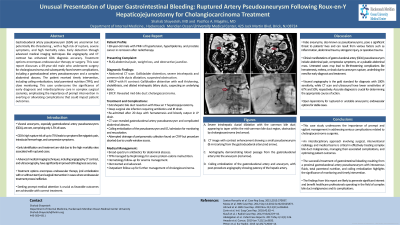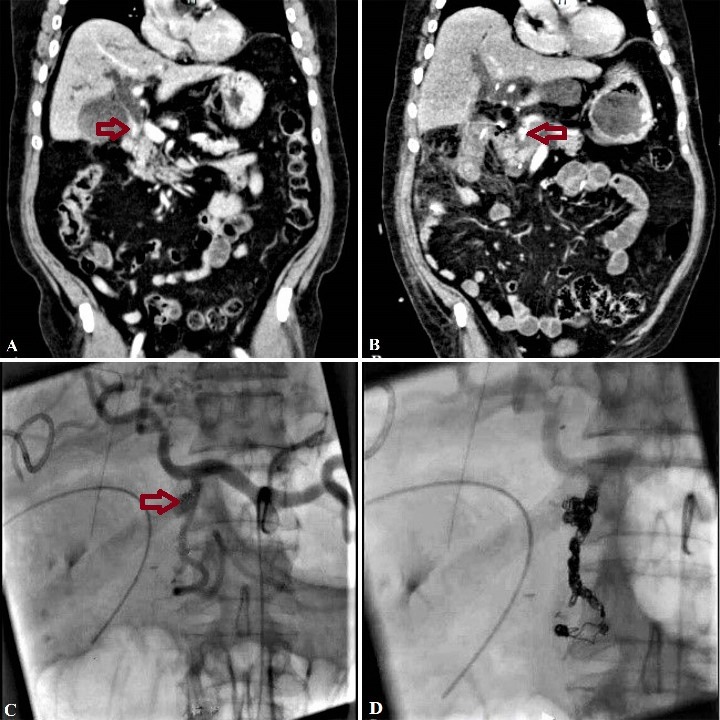Monday Poster Session
Category: Biliary/Pancreas
P1550 - Unusual Presentation of Upper Gastrointestinal Bleeding: Ruptured Artery Pseudoaneurysm Following Roux-en-Y Hepaticojejunostomy for Cholangiocarcinoma Treatment
Monday, October 23, 2023
10:30 AM - 4:15 PM PT
Location: Exhibit Hall

Has Audio

Shahab Shayesteh, MD
Hackensack Meridian Ocean Medical Center
Brick, NJ
Presenting Author(s)
Shahab Shayesteh, MD, Pacifico A. Magahis, MD
Hackensack Meridian Ocean Medical Center, Brick, NJ
Introduction: Gastroduodenal artery aneurysms (GDA) are a rare but significant type of visceral aneurysms due to their high rupture risk, which can lead to severe symptoms and high mortality rates. Advanced medical imaging techniques have improved the accuracy of GDA diagnosis, and treatment options include endovascular therapy or surgical intervention. Seeking prompt medical attention is crucial, and the prognosis is favorable with the correct treatment.
Case Description/Methods: This article highlights the case of a 69-year-old male who underwent surgery for cholangiocarcinoma and suffered from life-threatening complications, including a gastroduodenal artery pseudoaneurysm and a complicated abdominal abscess. The patient received timely intervention and management, including coiling embolization, TPN, and close monitoring. This case underscores the importance of early diagnosis and collaborative interdisciplinary care in complex surgical cases.
Discussion: This article stresses the critical importance of early diagnosis and treatment of gastro-duodenal artery pseudoaneurysms after cholangiocarcinoma surgeries. The case study presented underscores the need for careful surveillance and prompt management to achieve optimal patient outcomes. The report highlights the significance of interdisciplinary collaboration among surgical, interventional radiology, and medical teams to address complex bile duct malignancies and their associated complications. The article concludes that early intervention can prevent or mitigate complications that could impact patient outcomes.

Disclosures:
Shahab Shayesteh, MD, Pacifico A. Magahis, MD. P1550 - Unusual Presentation of Upper Gastrointestinal Bleeding: Ruptured Artery Pseudoaneurysm Following Roux-en-Y Hepaticojejunostomy for Cholangiocarcinoma Treatment, ACG 2023 Annual Scientific Meeting Abstracts. Vancouver, BC, Canada: American College of Gastroenterology.
Hackensack Meridian Ocean Medical Center, Brick, NJ
Introduction: Gastroduodenal artery aneurysms (GDA) are a rare but significant type of visceral aneurysms due to their high rupture risk, which can lead to severe symptoms and high mortality rates. Advanced medical imaging techniques have improved the accuracy of GDA diagnosis, and treatment options include endovascular therapy or surgical intervention. Seeking prompt medical attention is crucial, and the prognosis is favorable with the correct treatment.
Case Description/Methods: This article highlights the case of a 69-year-old male who underwent surgery for cholangiocarcinoma and suffered from life-threatening complications, including a gastroduodenal artery pseudoaneurysm and a complicated abdominal abscess. The patient received timely intervention and management, including coiling embolization, TPN, and close monitoring. This case underscores the importance of early diagnosis and collaborative interdisciplinary care in complex surgical cases.
Discussion: This article stresses the critical importance of early diagnosis and treatment of gastro-duodenal artery pseudoaneurysms after cholangiocarcinoma surgeries. The case study presented underscores the need for careful surveillance and prompt management to achieve optimal patient outcomes. The report highlights the significance of interdisciplinary collaboration among surgical, interventional radiology, and medical teams to address complex bile duct malignancies and their associated complications. The article concludes that early intervention can prevent or mitigate complications that could impact patient outcomes.

Figure: A. Severe intrahepatic ductal dilatation with the common bile duct appearing to taper within the mid-common bile duct region, obstruction at this level by cholangiocarcinoma shown by the red arrow.
B. The coronal CT image with contrast enhancement reveals a small pseudoaneurysm measuring 8 mm, which arises from the gastroduodenal artery shown by the red arrow.
C. The aortography performed prior to the coil embolization procedure demonstrates the passage of blood from the gastroduodenal artery into the aneurysm indicated by the red arrow.
D. Utilizing microcatheter numerous coils were placed to obtain stasis within the gastroduodenal artery and aneurysm. Postprocedure angiography demonstrated a good result with patency of the hepatic artery.
B. The coronal CT image with contrast enhancement reveals a small pseudoaneurysm measuring 8 mm, which arises from the gastroduodenal artery shown by the red arrow.
C. The aortography performed prior to the coil embolization procedure demonstrates the passage of blood from the gastroduodenal artery into the aneurysm indicated by the red arrow.
D. Utilizing microcatheter numerous coils were placed to obtain stasis within the gastroduodenal artery and aneurysm. Postprocedure angiography demonstrated a good result with patency of the hepatic artery.
Disclosures:
Shahab Shayesteh indicated no relevant financial relationships.
Pacifico A. Magahis indicated no relevant financial relationships.
Shahab Shayesteh, MD, Pacifico A. Magahis, MD. P1550 - Unusual Presentation of Upper Gastrointestinal Bleeding: Ruptured Artery Pseudoaneurysm Following Roux-en-Y Hepaticojejunostomy for Cholangiocarcinoma Treatment, ACG 2023 Annual Scientific Meeting Abstracts. Vancouver, BC, Canada: American College of Gastroenterology.
